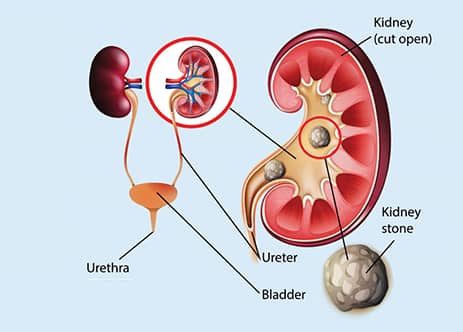Kidney Stone Specialist & Treatment in Moshi, Bhosari
Kidney Stone Specialist & Treatment in Moshi, Bhosari
Kidney stone is deposit ofMinerals &/or acid salts formed in concentrated urine in the kidney. These stones may thence stay as it in kidney or migrate to ureter or below. Kidney stones have varied presentation: being incidentally detected to even presenting as renal failure from long standing obstruction at the other spectrum.
Stones may be formed if you drink less fluids (have concentrated urine), there is excess of stone promoting substances and/or salts in urine (e.g. excess uric acid, oxalates, etc) or reduced quantities of stone formation inhibitors (reduced citrates, etc.) in urine. There are various types of stones, most common ones being calcium oxalate, calcium phosphate, struvite or triple phosphate stones.

(please insert pics of few stones from internet, calcium stones, uric acid or struvite stones)
What are signs or symptoms of stone disease?
1. Asymptomatic and incidentally detected on abdominal imaging
2. Symptomatic and may present one or more of the following symptoms:
- Persistent abdominal and/or flank pain, pain that may spread from back or side of abdomen towards groin, pain that comes in waves and subsides temporarily (colicky pain)
- Nausea and vomiting
- Passage of blood or clots or gravel in urine
- Urinary tract obstruction causing decreased urine output
- Pain during passing urine, fever, foul smelling urine (Infection)
- Decreased kidney function and its manifestations
What are common risk factors for stone formation?
The lifetime risk of formation of kidney stones is about 13 to19% in men and 7 to 9% in women. Almost one in 9 persons may develop stones over their lifetime. The 5year risk of recurrence after first stone event or having second stone formation is almost 35 to 50% in absence of specific treatment. Your chance of stone formations increases if:
- Family or personal history of kidney stones
- Low fluid intake
- Prolonged consumption of diets high in protein, salt, or sugar
- Obesity has been linked to an increased risk of kidney stones.
- Underlying medical conditions may predispose to stone formation: high blood pressure, diabetes, certain GI surgeries and cystinuria may increase the risk for kidney stones.
What tests are done to diagnose kidney stones?
Diagnosis begins with medical history taking followed by clinical examination and blood, urine and imaging tests. Ultrasound scanning, X ray &/or CT scan may be needed to accurately detect the stone, its density and site to guide appropriate management. Whenever available, stone should be sent for stone analysis to characterise its composition so that directed therapies can be used to prevent recurrence.
What treatment options are available for treatment of stones?
Treatment begins with prevention as ‘Prevention is best cure’. Treatment depends upon the site of stone, size of stone, type of stone, presence of infection or obstruction to urinary flow, renal function and patient preference.
As general measure, you need to increase your fluid intake to more than 2.5L per day, cut back on salt intake, avoid fruit juices, soft drinks, cut back on red meat quantity. Stones smaller in size, usually less than 8 to 10 mm may pass spontaneously or with aid of tablets to facilitate expulsion. However surgical intervention may be needed if stones are either infected or causing obstruction or patient symptomatic despite medical measures.
The following types of medical procedures may be needed to treat stones:
- Lithotripsy
- Percutaneous Nephrolithotomy (Nephrolithotripsy)
- Shock Wave Lithotripsy
- Ureteroscopy
